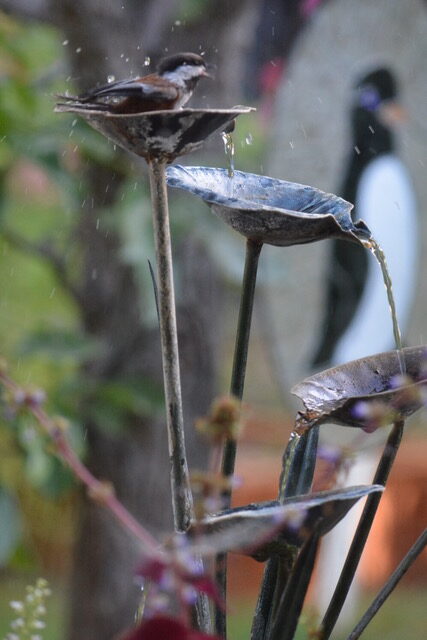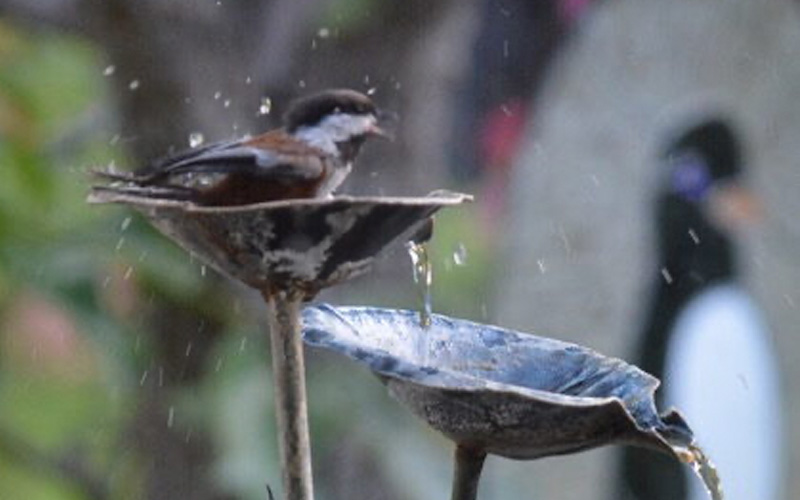Crow
How black is that crow sitting way up there near the top of that Dr. Seuss-like eucalyptus tree? So black that it looks like negative space; like a perfect crow shape has been cut out of the blue sky to reveal the blackness of outer space beyond. Black licorice, my favorite kind, a chunk of obsidian, a coal mine at midnight, Crow is that black! I peer through my binoculars and can see its iridescent feathers glowing as they reflect the rays of a rapidly setting sun. The tree is perhaps 200 feet tall and Crow is perched maybe 20 feet from the top. Like the Maltese Falcon, like a gargoyle atop a New York City skyscraper, Crow gazes down upon us earthbound creatures. What is it thinking? Are its motives altruistic or does Crow have something more sinister in mind? Crow occasionally lets loose with one of its vocalizations which is a cross between a ratchet and a gargle; it’s creepy and causes me to shudder.
The term “bird brain” connotes simplemindedness, but for birds and especially crows this is a complete misnomer. Birds possess great intelligence. The corvids (crows and jays) are among the smartest in the avian world. It’s with this in mind that I wonder what Crow is up to. I’m pretty sure that it has a nest somewhere up there. Crow and its friends noisily chase away any bird that dares to come near. Even the Red Shouldered hawk, a large and powerful predator, is no match. Don’t mess with Crow!
Jay
Scrub Jay is the undisputed ruler of its backyard domain It glides from tree to tree like a blue arrow with the confidence that no other bird would dare challenge it. Smaller birds quickly scatter when Scrub approaches the feeders. With staccato jabs its pointed beak probes the seed well. Seeds fly as Scrub searches for its favorite morsel. Oak titmice and chickadees eye the feeder with envy from a nearby tree, waiting until Scrub has had its fill before swooping in for their turn.
One of our deck fountains doubles as a bird bath. Scrub and its avian underlings make ample use of it for drinking and bathing. Of course Scrub is “top dog” here as well. I love watching it dip its beak in and out of the water, taking imperceptibly tiny sips until it has quenched its thirst.
Scrub is blue and it’s a jay but it is not a Blue Jay, that distinction belongs to a jay that lives east of The Rockies and bears little resemblance to Scrub and its cousin the Stellar’s Jay. The blue shade of Scrub’s wing, tail and head feathers is deeply saturated and particularly vivid when viewed in the bright, flat light of a summer afternoon. Scrub jays are one of the more common birds in our area. I find it a stunningly gorgeous bird who’s beauty is not diminished one bit by its familiarity. I can imagine the reaction of someone who has never seen a scrub jay.
Chickadee
The Chestnut backed chickadee is a feisty little bird. It flits around our yard with urgent purpose, zipping from tree branch to feeder to fountain like a sprite on too much caffeine. Chickadee is curious to the point where I could almost give it the human characteristic of being friendly. Hummingbirds will sometimes dive bomb me but those are fleeting encounters. However with Chickadee, I can often get within a couple of feet it. Sometimes Chickadee will even approach me! These visits can last a minute or two and have an air of magic to them. I’ll look at Chickadee and it will look at me. I’ll say something like, “Hey there little bird” and it responds with a soft click or chip. I wonder how it perceives me? Birds are smart creatures and we can never truly know the mind of an animal so anything I think about Chickadee’s level of awareness is pure conjecture.
Chickadee appears to be a happy bird, but then again all birds seem happy to me. I mean, wouldn’t you be if you could fly? There’s a metal fountain on our deck that’s about two feet high. The water cascades down a series of five faux seashells, each shell is a mini bird bath and the perfect size to fit the body of a chickadee. Nowhere in our yard does Chickadee appear happier than when it’s bathing in one of the shells. The top tier is its preferred spot. Chickadee will land, dip its beak, flap its wings and wiggle its tiny body, creating a corona of water droplets in a display of unbridled avian ecstasy.
Chickadee’s colors are a series of broad brushstrokes in earth tone hues. A dark brown head gives way to a broad cream colored band across its eyes, ending in a black chin. Its back and sides are a deep, rusty brown, its wings dark with white bands, its breast white. Chickadee isn’t flashy like an oriole or a tanager, its beauty is more subtle. This bird is easy to observe, allowing me more time to appreciate its unique combination of colors and patterns


Hot dog gets ketchup!!!!
I am not having this from you!! A man who "would not pay it" for mustard now goes and writes…
Sounds familiar!!! nice Louie man
Has to be said! Thanks for saying it Louie.
Louie, so happy we got to be there sharing your porch swing with just the right timing to see this…